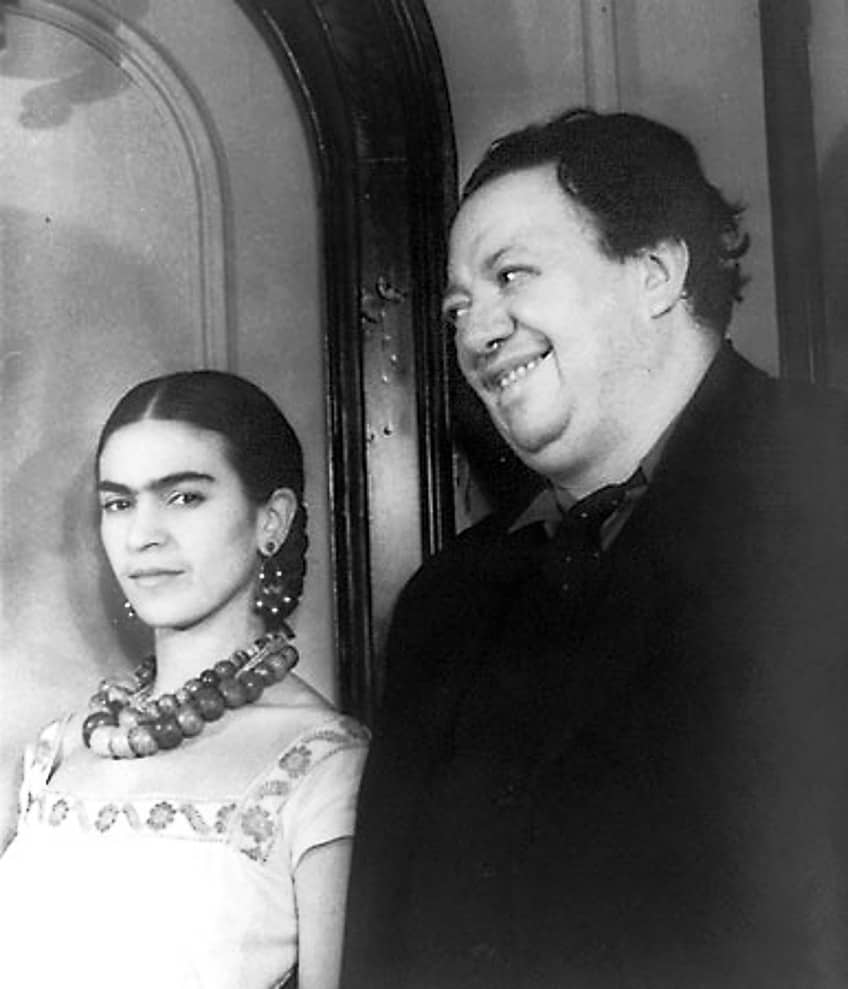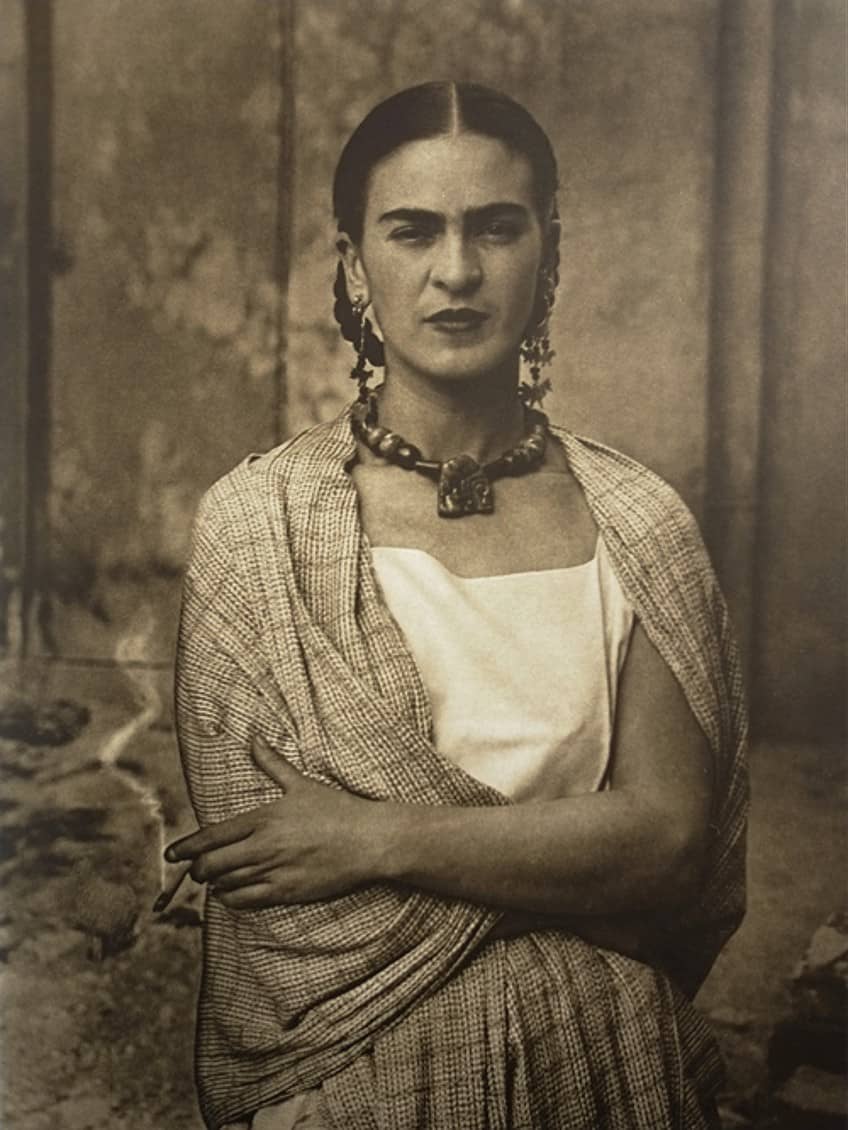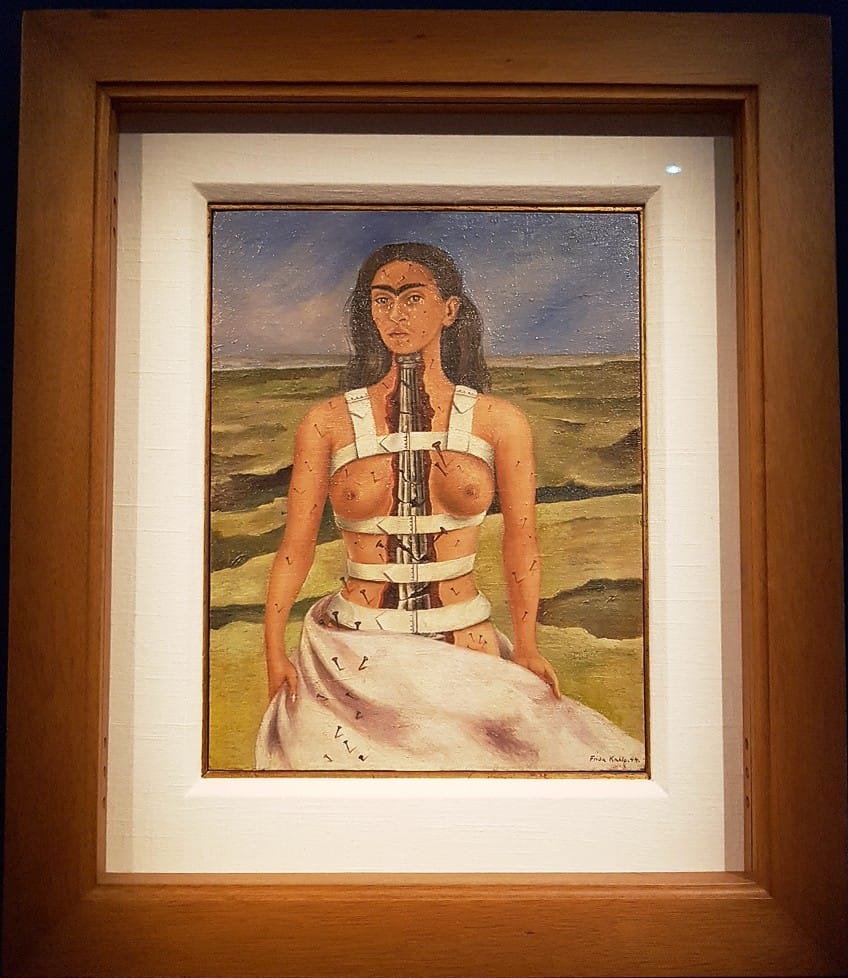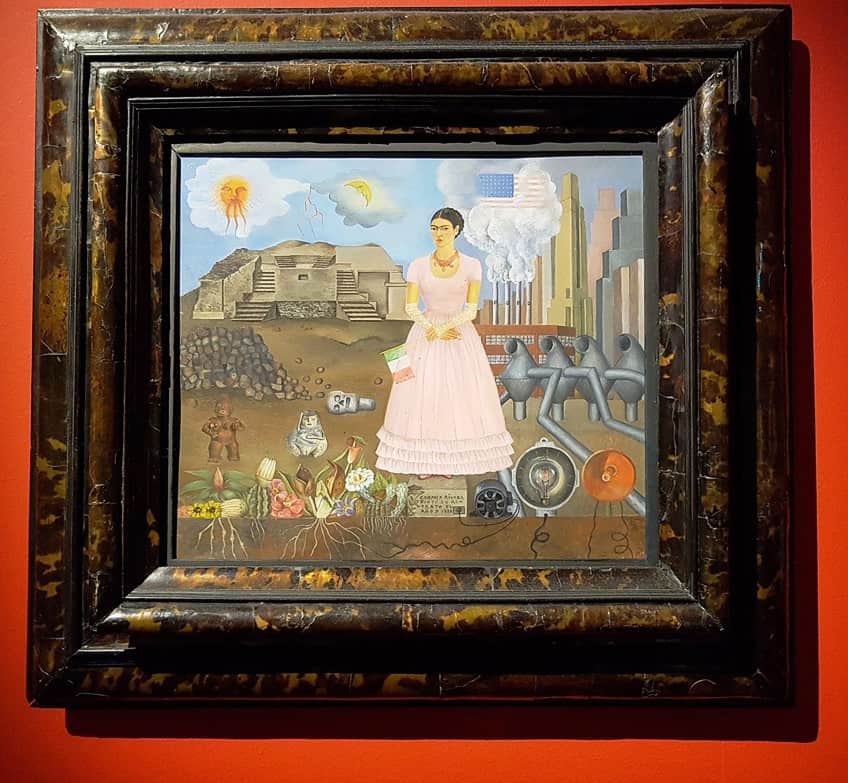“The Two Fridas” by Frida Kahlo – A Look at Frida Kahlo’s Iconic Art
The Two Fridas by Frida Kahlo is a classic example of all the artistic characteristics that made this Mexican artist so significant and ensured her legacy continues today. In this article, we will look at The Two Fridas meaning by doing a visual analysis of the two friends painting. This painting, also called Los Dos, gives us so much insight into Frida Kahlo and her personal struggles with identity, heritage, and isolation.
Contents
Artist Abstract: Who Was Frida Kahlo?
Frida Kahlo (1907 – 1954) was a highly-regarded Mexican artist known for her emotive and symbolic self-portraits that often reflected her physical and emotional pain. There are a few aspects that influenced Frida Kahlo’s artistic life and for the purpose to understand The Two Fridas painting fully, we need to pause here in the artist’s abstract section and look at each aspect.
A Brief Summary of Frida Kahlo’s Early Life
Born in 1907 in Coyoacán, Mexico, she spent her childhood and early adulthood in Mexico City. With a mixed heritage, her father German and her mother Mexican, her background played a role in her later art and life. This mixed heritage aspect of her personality and work will become very clear in The Two Fridas analysis section of the article.
Throughout her childhood, Kahlo was plagued by health challenges, including polio, which left her with a limp. In her teenage years, she was gravely injured in a bus accident and spent a year recovering in a full-body cast.

During this time, she discovered her passion for art and began to experiment with painting and drawing as a way to pass the time and express her emotions. As she developed her skills over the years, she began to pursue art more seriously. In the early 1920s, she attended the National Preparatory School in Mexico City, where she met Diego Rivera (1886 – 1957), a well-established muralist who she would later marry.
Despite the age gap and Rivera’s established career, the two were deeply in love, and their relationship was a major inspiration in her art.
A Brief Summary of Frida Kahlo’s Life with Diego
Her paintings, such as The Two Fridas (1939), The Broken Column (1944), The Wounded Deer (1946), The Suicide of Dorothy Hale (1938), and The Dream (1940), explored her physical and emotional pain, her relationship with Rivera, and the cultural and political climate of Mexico in the 1930s and 1940s.
Her work was heavily influenced by Mexican muralists and indigenous culture, and she developed a unique style and voice through her self-portraits, which became the focal point of her art.

For the purpose of this article, it is important to understand that Frida Kahlo saw Diego Rivera as the biggest tragedy in her life – even more so than the horrific tram and bus accident she was in. Even though their marriage offered her a lot of happiness and passion, they had a tumultuous relationship fraught with infidelities and spitefulness.
A Brief Summary of Frida Kahlo’s Artistic Life
In addition to her exploration of the human condition through her self-portraits, Kahlo’s work also had surrealist elements, featuring dreamlike and fantastical imagery. She was closely connected to the Mexican Surrealist movement and her art has been seen as highly symbolic and political, and she has been celebrated as a feminist icon. Frida Kahlo’s impact on art history is undeniable and her work continues to be studied and celebrated to this day.
She is regarded as one of the most important artists of the 20th century, and her focus on self-expression, emotional pain, and political and social issues still resonates with audiences today.
The Two Fridas by Frida Kahlo in Context
| Date | 1939 |
| Medium | Oil on masonite |
| Type of Painting | Self-portrait |
| Movement | Surrealism and symbolism |
| Dimensions (cm) | 174 x 173 |
| Location | Museo de Arte Moderno, Mexico City, Mexico |
Frida Kahlo’s The Two Fridas is a powerful and emotionally charged painting that is considered one of her most iconic works. The painting reflects the artist’s deep sense of self, her understanding of identity, and the continuous process she undertook in her life to understanding herself deeply through the art she created.
The Two Fridas by Frida Kahlo in the Context of Her Life
The Two Fridas painting was created during a difficult period in Kahlo’s life. Her marriage to the artist Diego Rivera was in turmoil, and she had recently undergone major surgery. The painting reflects the emotional turmoil and pain that she was experiencing at the time, and it also reflects the questioning of her identity and her relationship with others. The Two Fridas was also an important painting for Frida Kahlo in a more professional sense, as it was one of the works that were selected for her first solo exhibition outside of Mexico in 1940 in the gallery of the Art Institute of Chicago.
This exhibition helped to establish Kahlo as one of the most important artists of the 20th century, and it also helped to put Mexican art on the international map.

The painting also influenced other artists and art movements, such as the feminist and surrealist movements. Her work, specifically this painting, has been celebrated for its feminist perspective and its ability to empower women by giving them a voice. The use of symbolism and metaphor, as the strong, self-referential, and personal subject matter, are all elements that have been influential to other artists in their own practices. Kahlo’s paintings are widely recognized as a representation of her unique perspective on the world around her. Her work is not only considered a powerful representation of the human experience, but also a celebration of Mexican culture and identity.
The Two Fridas is a powerful illustration of how Kahlo used her art to explore and express her feelings, identity, and beliefs.
Contextual Analysis: A Brief Mexican Socio-Historical Overview of The Two Fridas
The Two Fridas by Frida Kahlo was painted in 1939, during a time of significant political and cultural upheaval in Mexico. The painting was created in the aftermath of the Mexican Revolution, a period of intense social and political change that lasted from 1910 to 1920. During this time, Mexico underwent a radical transformation, as new leaders emerged and sought to reshape the country’s political and social landscape.
As a result, the cultural climate of Mexico was one of experimentation and experimentation and re-evaluation of Mexican identity. Artists, including Kahlo, were drawn to this idea of revolution, depicting in their works the country’s indigenous and national roots.
These works became a representation of a new and modern Mexico, different from the country’s past, and these artists helped to shape a new cultural identity. Kahlo, who was of indigenous and Spanish heritage, often depicted herself in her paintings as a representation of Mexican culture and identity. The Two Fridas is no exception; the two figures dressed in traditional Tehuana clothing show a strong connection to her indigenous roots, and their physical and emotional bond is a powerful representation of Mexican culture and their internal conflict.
Contextual Analysis: A Brief Western Socio-Historical Overview of The Two Fridas
The painting was first exhibited in 1940 in the United States, at the Julien Levy Gallery in New York City. At the time, it was considered quite avant-garde, and it was well-received by the art world in the US. This exhibition was a great opportunity for Frida to have her work exposed to a different culture, and it helped to establish her reputation as a prominent artist. However, in the Western context, the painting was often misunderstood, and the meaning was lost in translation.
The Two Fridas painting was seen as a representation of Mexican culture and identity but the emotional and psychological aspect of the painting, which was the main focus for Kahlo, was often overlooked.

The Two Fridas Analysis
In this section of the article, we will do an in-depth visual analysis of The Two Fridas painting (originally titled Los Dos). By looking at the composition structure, subject matter, light and color use, perspective, and symbolism Frida Kahlo applied in creating this artwork, we might gain insight into what made her such a prolific artist.
Compositional Overview
The painting features two versions of the artist, sitting side by side and holding hands, with their hearts exposed. The composition of this monumental painting is organized around a central axis, with the two figures symmetrically placed in the middle of the canvas. Both figures are sitting upright on a bench. Something in their posture and gazes reflects a sense of pride but also a deep vulnerability.
The background is filled with a stormy sky which gives a sense of tension and drama. The figures are dressed in beautiful dresses – the Frida on the left is wearing a more western style white dress and the Frida on the right is in traditional Tehuana clothing.
Even though they are not looking at each other, there is a sense of intimacy between them. This intimacy is illustrated further by the heart connection between the two Fridas. There is an open vein running between them above their shoulders, and a severed vein that is bleeding out on the skirt of the Frida on the right.
The right-hand Frida is holding a small locket between her figures that has a photograph of Diego in it. The Frida on the left is holding a scissor in her lap with which it seems she has cut the second vein connected to the traditional Frida’s heart. The overall composition of the painting is dynamic and creates a sense of movement besides the fact that the Fridas seem to sit very still. It is as if the figures are leaning towards each other in support, but also actively engaging the gaze of the viewer while their hearts are bleeding.
Subject Matter
The subject matter of the painting is the artist herself, and it is a representation of the duality of her personality and identity. The two Fridas in the painting are not identical but are different, representing the public and private aspects of the artist’s life.
The painting also shows the connection between Frida’s indigenous and Mexican heritage, as she is shown wearing traditional Tehuana clothing. The painting is a self-portrait, but unlike many of her other self-portraits, it does not depict her in the context of her physical pain.
Instead, it shows her emotional pain and the inner turmoil that she was experiencing at the time. Therefore, it could be said that the painting is also about her relationship with Diego even though he just features as a very small figure in the locket in the traditional Fridas lap. Frida is facing her isolation in this painting and, therefore, the subject matter includes all that she had to leave behind with the divorce between her and Diego settled.
Color and Light
The color palette used in the painting is muted, with mostly cool colors, such as blue and gray, being used in the background, creating a sense of melancholy and isolation. That being said, the contrasting warm colors Frida Kahlo included in the dresses and hearts of the figures create a vibrant effect that adds to the feeling of turmoil.
The flesh tones of the figures are warm and lifelike, which also creates a sense of contrast with the background.
The red color of the hearts and the dress of the figure on the right, also add to the tension and drama of the painting. The use of the red color also symbolizes the emotional pain that Kahlo was experiencing. The use of color also helps to create a sense of depth and movement in the painting.
Texture
The texture in the painting is highly detailed, with intricate patterns and textures being used to create a sense of depth and dimensionality. The clothing of the figures is rendered with great care and attention to detail, with the embroidery and beadwork being particularly striking. The skin tones are also rendered with great care, creating a sense of realism and dimensionality.
The use of texture in the painting helps to create a sense of authenticity, which is further heightened by the use of light.
Perspective
The perspective in the painting is unusual, as the two figures are shown from a slightly angled perspective, creating a sense of movement and dynamism. The forms in the painting are simplified and stylized, which gives the painting a sense of abstraction. The figures are elongated, with their limbs being stretched out, which creates a sense of motion and tension.
The use of form in the painting also adds to the illusion of movement and energy, and it adds to the overall sense of emotional agitation.
This juxtaposition of realistic forms in a dream-like landscape is typical of Surrealism, which was developing parallel to Frida Kahlo’s career in Europe. Even though Kahlo rejected the classification of her work as surrealistic, the perspective and cloudy landscape with the two realistic life-size figures sitting on an isolated bench gives us a clue as to why the Surrealists wanted to lay claim to her work.
Symbolism: The Two Fridas Meaning
In order to understand The Two Fridas meaning, we need to look closely at the dense network of symbols Frida Kahlo included in this artwork. The symbolism in the painting is rich and multi-layered, with the two figures representing the duality of the artist’s personality and identity. The direct and stoic gazes of the two figures represent a moment of disillusionment Kahlo is experiencing with herself – as if to have a very truthful conversation with the different parts of herself about her isolation and identity after settling her divorce with Rivera. The confrontation of her gaze also symbolizes the strength and courage she is drawing from the inevitable end of their rocky marriage.
The painting is also a reflection of Kahlo’s connection to her Mexican heritage. The traditional Mexican clothing worn by the figure on the right in the painting reflects the artist’s strong connection to her home country and its culture.
That being said, Frida Kahlo famously started wearing traditional Mexican dresses as a way to please Diego – as he loved what she represented for their country donned in the ancient styles. The conflict between the two styles – one being more formal and western than the earthy traditional clothing – can therefore also represent confusion in Kahlo about her identity.
The image of two Fridas holding hands also reflects the idea of duality and the idea of two parts of oneself. This “two friends” painting speaks of the camaraderie Frida Kahlo finds in herself and in her constant project of knowing herself through art.
The exposed hearts in the painting represent the emotional pain that Kahlo was experiencing. The stormy sky in the background represents the inner turmoil and conflict that Frida was experiencing. The painting is a powerful representation of Frida Kahlo’s emotional and psychological state at the time, and it is a reflection of the cultural and political climate of Mexico as well.
Why Is The Two Fridas by Frida Kahlo So Influential?
When The Two Fridas painting was first shown, it was widely attended and the artwork was well-received by the public. Until today, this painting has left audiences in awe and emotionally charged. Let us look more closely at how it was first received, what prominent critics had to say, and how Frida Kahlo’s lineage continues today.
The Critics’ Opinion and the Reception at the First Exhibition
Frida Kahlo’s The Two Fridas painting was first exhibited in 1939 in Mexico City at the Palacio de Bellas Artes in an exhibition organized by the Mexican Communist Party. The painting had a profound impact on the public and critics alike. The exhibition was widely attended and the painting was met with great interest and curiosity from the public. The painting was later exhibited in 1940 at the Julien Levy Gallery in New York City, becoming one of the first exhibitions of Frida Kahlo’s work in the United States.
The exhibition marked a turning point in Kahlo’s career, introducing her art to a wider audience and helping to establish her reputation as a prominent artist.
One of the first art critics to comment on The Two Fridas was Julian Levy (1906 – 1981), the gallery owner where the painting was first shown in the US. He praised Kahlo’s work calling her a “great artist” and describing the painting as “fascinating” and “unforgettable”. Another important critic of the time, Clement Greenberg (1909 – 1994), also wrote about the painting, although his opinion was not as positive. He wrote that The Two Fridas was a “minor work” and criticized its “lack of skill” in the painting. He noted that it lacked the technical mastery of other contemporary artworks.
In Mexico, the artist and critic, Carlos Merida (1891 – 1984), was among the first to write about the painting and had a positive perception of the painting. He praised its symbolism and meaning, describing it as “a powerful representation of the artist’s pain and inner turmoil”
Frida Kahlo’s Impact on Today’s Art Audience
Today Frida Kahlo is still a renowned artist known for her emotive self-portraits and her use of symbolism to express personal and political themes. Her highly personal self-portraits are still some of the biggest attractions in Mexico City, as well as the house she lived in as a child and later in her life again during her second marriage to Diego Rivera. Her artworks have touched audiences as they so vulnerably express issues of physical and emotional pain, identity, gender, and class, earning her recognition as a feminist icon. Her use of color, composition, and technical skill in her paintings are also noteworthy, as is her ability to reflect the social and political climate of Mexico through her art.
Perhaps on the same level of fame as her artworks, is Frida Kahlo’s eventful and tragic life. Her life story, and the way she overcame physical and emotional pain, have made her an important figure and an icon of resistance in the art world.

Today, her work continues to inspire contemporary artists, and her legacy is celebrated in exhibitions and publications worldwide. Frida Kahlo’s art is widely recognized as a representation of the emotional and psychological experience of the individual. Through her work, she has captured the public imagination and has become an enduring symbol of the strength, resilience, and power of the human spirit. The Two Fridas is just one of the many works that have cemented her place as one of the most important artists of the 20th century.
In conclusion, Frida Kahlo’s The Two Fridas is a powerful and emotionally charged painting that reflects the artist’s deep sense of self and her understanding of identity. The painting was created during a difficult period in Kahlo’s life, reflecting the emotional turmoil and pain that she was experiencing. It also reflects her connection to her Mexican heritage, which was an important part of her identity and culture.
Frequently Asked Questions
When Was The Two Fridas by Frida Kahlo First Exhibited?
The Two Fridas by Frida Kahlo (1907 – 1954) was first exhibited in Mexico in 1940 at the Galería de Arte Mexicano. The painting was also selected for her first solo exhibition outside of Mexico in 1940, which helped to establish her as one of the most important artists of the 20th century and also helped to put Mexican art on the international map. It was then exhibited in the United States for the first time in 1941 at the Museum of Modern Art in New York City.
What Is The Two Fridas Meaning?
The painting The Two Fridas (or Los Dos) by Frida Kahlo (1907 – 1954) is a self-portrait depicting the artist sitting side by side with a mirror image of herself. The two friends painting shows how the two versions of Frida are connected by a shared blood vessel, symbolizing the deep connection and bond between them. The painting is often interpreted as a representation of Kahlo’s dual identity and her struggles with her own sense of self. It is also interpreted as a representation of the emotional pain and suffering she experienced due to her tumultuous relationship with Diego Rivera (1886 – 1957), as well as her feelings of isolation and loneliness. Some critics have also interpreted the painting as a feminist statement about the power of self-discovery and self-acceptance.
What Did Frida Kahlo Do After Painting The Two Fridas?
After The Two Fridas was exhibited with other paintings by Frida Kahlo (1907 – 1954) in New York, Kahlo continued to paint and exhibit her work throughout her life. She had her first solo exhibition in Mexico City in 1953, and her work began to gain international recognition in the 1950s and 1960s. She continued to face health problems throughout her life, due to a bus accident she had in her youth, but remained active in the art world. She had several solo shows in Mexico and the United States, and her work was included in several group exhibitions. She continued to paint until her death in 1954. Even though she did not gain widespread recognition during her lifetime, her work has since become highly celebrated.
Nicolene Burger, a South African multimedia artist and creative consultant, specializes in oil painting and performance art. She earned her BA in Visual Arts from Stellenbosch University in 2017. Nicolene’s artistic journey includes exhibitions in South Korea, participation in the 2019 ICA Live Art Workshop, and solo exhibitions. She is currently pursuing a practice-based master’s degree in theater and performance. Nicolene focuses on fostering sustainable creative practices and offers coaching sessions for fellow artists, emphasizing the profound communicative power of art for healing and connection. Nicolene writes blog posts on art history for artfilemagazine with a focus on famous artists and contemporary art.
Learn more about Nicolene Burger and about us.
Cite this Article
Nicolene, Burger, ““The Two Fridas” by Frida Kahlo – A Look at Frida Kahlo’s Iconic Art.” artfilemagazine – Your Online Art Source. March 15, 2023. URL: https://artfilemagazine.com/the-two-fridas-by-frida-kahlo/
Burger, N. (2023, 15 March). “The Two Fridas” by Frida Kahlo – A Look at Frida Kahlo’s Iconic Art. artfilemagazine – Your Online Art Source. https://artfilemagazine.com/the-two-fridas-by-frida-kahlo/
Burger, Nicolene. ““The Two Fridas” by Frida Kahlo – A Look at Frida Kahlo’s Iconic Art.” artfilemagazine – Your Online Art Source, March 15, 2023. https://artfilemagazine.com/the-two-fridas-by-frida-kahlo/.



